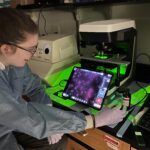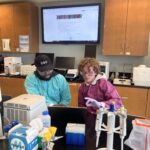Dr. Phillip Brown

Research Areas:
- Whole genome sequence analysis
- Epidemiology
- Horizontal gene transfer
- Antimicrobial resistance
- CRISPR-equipped bacteriophage
Techniques:
- Molecular cloning
- DNA-sequencing
- Graphical interface bioinformatics
- CRISPR-Cas12a
- CRISPR-associated transposons
Project Description:
The Centers for Disease Control and Prevention has labelled bacterial antimicrobial resistance (AMR) a global threat [1] due to the consistent increase in yearly AMR-associated human cases [2,3]. AMR is most concerning in six “ESKAPE” bacteria (Enterococcus faecium, Staphylococcus aureus, Klebsiella pneumoniae, Acinetobacter baumannii, Pseudomonas aeruginosa, and Enterobacter species) due to their role in hospital-acquired infections [4]. However, AMR in non-pathogenic bacteria is also concerning as these bacteria have been shown to be a reservoir for AMR genes, which can be horizontally transferred into human pathogens [5,6]. While being extremely useful traditional antimicrobial compounds are typically non-specific and target a wide range of microbes, including beneficial bacteria, depending on their mechanism of action [7]. The emergence of high throughput sequencing techniques and utilization of CRISPR-Cas systems has allowed for a more specific targeting of bacteria carrying specific genes or sequences [8].
Summer research students will use whole genome sequence data to design CRISPR-Cas systems to combat non-pathogenic antimicrobial resistant bacteria. These CRISPR-Cas systems may target essential genes to directly kill the bacteria, or AMR genes to re-sensitize the bacteria to the corresponding antimicrobial compound. Previous experience in molecular cloning, bioinformatics tools or CRISPR-Cas systems is not necessary, if you are interested in working towards a solution for the AMR crisis or using CRISPR-Cas systems this project is for you.
References:
- Centers for Disease Control and Prevention. https://www.cdc.gov/DrugResistance/
- Antimicrobial Resistance Collaborators. 2022. Global burden of bacterial antimicrobial resistance in 2019: a systematic analysis. Lancet. 400:1102. doi: 10.1016/S0140-6736(21)02724-0.
- World Health Organization. https://www.who.int/news/item/09-12-2022-report-signals-increasing-resistance-to-antibiotics-in-bacterial-infections-in-humans-and-need-for-better-data
- Rice LB. 2008. Federal funding for the study of antimicrobial resistance in nosocomial pathogens: no ESKAPE. J Infect Dis. 197:1079-81. doi: 10.1086/533452.
- Poirel L, Madec JY, Lupo A, Schink AK, Kieffer N, Nordmann P, Schwarz S. 2018. Antimicrobial resistance in Escherichia coli. Microbiol Spectr. 6(4). doi: 10.1128/microbiolspec.ARBA-0026-2017.
- Soucy SM, Huang J, Gogarten JP. 2015. Horizontal gene transfer: building the web of life. Nat Rev Genet. 16(8):472-82. doi: 10.1038/nrg3962.
- Maier L, Goemans CV, Wirbel J, Kuhn M, Eberl C, Pruteanu M, Müller P, Garcia-Santamarina S, Cacace E, Zhang B, Gekeler C, Banerjee T, Anderson EE, Milanese A, Löber U, Forslund SK, Patil KR, Zimmermann M, Stecher B, Zeller G, Bork P, Typas A. 2021. Unravelling the collateral damage of antibiotics on gut bacteria. Nature. 599:120-124. doi: 10.1038/s41586-021-03986-2.
- Jiang Y, Chen B, Duan C, Sun B, Yang J, Yang S. 2016. Multigene editing in the Escherichia coli genome via the CRISPR-Cas9 system. Appl Environ Microbiol. 82:3693. doi: 10.1128/AEM.04023-14.



